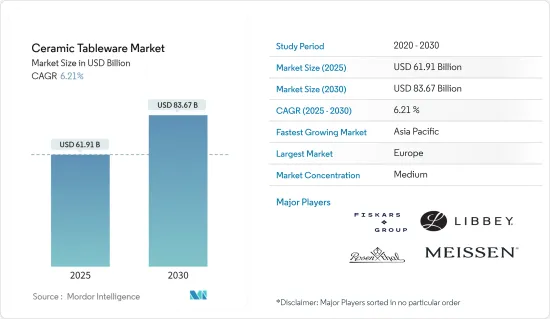PUBLISHER: Mordor Intelligence | PRODUCT CODE: 1689842

PUBLISHER: Mordor Intelligence | PRODUCT CODE: 1689842
Ceramic Tableware - Market Share Analysis, Industry Trends & Statistics, Growth Forecasts (2025 - 2030)
The Ceramic Tableware Market size is estimated at USD 61.91 billion in 2025, and is expected to reach USD 83.67 billion by 2030, at a CAGR of 6.21% during the forecast period (2025-2030).

The ceramic tableware market is projected to witness strong growth in the anticipated period. Some of the major factors driving the growth of the ceramic tableware market include an increasing number of home renovation projects, a rising number of household units, and an increase in the installation of modular kitchens. The food and beverage and home decor industries are also witnessing rapid growth which is expected to further propel the demand for ceramic tableware products in the anticipated period.
Globally, there is a steady rise in e-commerce that has created lucrative opportunities for producers and suppliers in the ceramic tableware industry to sell their products through online platforms. In order to cater to a wide range of customers across the globe, producers and suppliers of ceramic tableware are focusing on selling their products on various e-commerce portals.
In North American countries, there is also an increasing trend of living in rental houses which makes consumers change their houses often and, thus consumers prefer to have new tableware products in their new houses. This is eventually propelling the market demand for ceramic tableware products.
Ceramic Tableware Market Trends
Rapid Growth of Online Sales is Driving the Market
The sales of ceramic tableware through the online channel are growing swiftly due to the increasing penetration of the internet and smartphones globally. The factors such as ease of shopping, hefty discounts, and better payment and return policies are encouraging consumers to purchase ceramic tableware online. Moreover, the young working population with hectic schedules prefer online channels as their purchase medium rather than offline due to easy access and doorstep service. This, in turn, is expected to fuel the growth of the market in the forthcoming years.
In countries such as the United States and United Kindom, e-commerce based houseware and tableware product sales are increasing since the last few years and the growth trend is expected to continue. The online retail channel is also expanding rapidly in several other countries such as China, India, Germany, and the UK. The e-commerce channel will be an integral medium for ceramic tableware products worldwide and will contribute significantly to the ceramic tableware market growth in the forecast period.
Asia-Pacific and Europe are Dominating the Ceramic Tableware Market
The Asia Pacific is one of the fastest-growing regional markets for Ceramics tableware due to high demand from developing countries such as India and China. The rise in disposable income and brand consciousness has led to high demand for branded ceramic tableware in the Asia Pacific region. The increasing number of houses due to the growing population and rapid development is also a prominent driving factor. Moreover, the rising number of hotels, restaurants, and other options of dining out is fueling the regional market growth in the forecast period.
Europe is also one of the dominant markets in the ceramic tableware industry. In Europe Germany, the UK, and France are major producers of ceramics tableware and the European brands are anticipated to dominate the global high-end market for tableware products in the forecast period.
Ceramic Tableware Industry Overview
The global ceramic tableware market is highly competitive with the presence of some key players such as Fiskars Group, Rosenthal GmbH, Libbey, Meissen, Seltmann Weiden, RAK Porcelain, Villeroy & Boch, WMF, Lenox, and Churchill China. These players are projected to face tough competition in the forthcoming years due to the presence of a large number of local players in the market. The major brands are focussing on the innovation of new products and research and development activities to strengthen their footprint in the global ceramic tableware market. The companies are moving towards the expansion of their product portfolios by engaging in mergers and acquisitions and joint ventures with local brands. The manufacturers in developing countries are focusing on reducing their cost of production and increasing their profitability.
Additional Benefits:
- The market estimate (ME) sheet in Excel format
- 3 months of analyst support
TABLE OF CONTENTS
1 INTRODUCTION
- 1.1 Study Deliverables
- 1.2 Study Assumptions
- 1.3 Scope of the Study
2 RESEARCH METHODOLOGY
3 EXECUTIVE SUMMARY
4 MARKET INSIGHTS AND DYNAMICS
- 4.1 Market Overview
- 4.2 Market Drivers
- 4.3 Market Restraints
- 4.4 Market Opportunities
- 4.5 Industry Value Chain Analysis
- 4.6 Porter's 5 Force Analysis
- 4.7 Insights on tableware market for all material types
- 4.8 Insights on key trends in the industry
5 MARKET SEGMENTATION
- 5.1 By Type
- 5.1.1 Porcelain and Bone China
- 5.1.2 Stoneware (Ceramic)
- 5.1.3 Others
- 5.2 By End User
- 5.2.1 Household
- 5.2.2 Commercial
- 5.2.2.1 Accommodation and Hospitality Segment
- 5.2.2.2 Food Service Segment
- 5.2.2.3 Others
- 5.3 By Distribution Channel
- 5.3.1 Supermarkets & Hypermarkets
- 5.3.2 Specialty Stores
- 5.3.3 Wholesalers
- 5.3.4 Online
- 5.3.5 Others
- 5.4 By Geography
- 5.4.1 North America
- 5.4.2 Asia-Pacific
- 5.4.3 Europe
- 5.4.4 Latin America
- 5.4.5 Middle East and Africa
6 COMPETITIVE LANDSCAPE
- 6.1 Market Competion Overview
- 6.2 Company Profiles
- 6.2.1 Fiskars Group
- 6.2.2 Rosenthal GmbH
- 6.2.3 Libbey
- 6.2.4 Meissen
- 6.2.5 Seltmann Weiden
- 6.2.6 RAK Porcelain
- 6.2.7 Villeroy & Boch
- 6.2.8 WMF
- 6.2.9 Lenox
- 6.2.10 Churchill China
- 6.2.11 KAHLA Porzellan
- 6.2.12 SCHONWALD
- 6.2.13 Lenox
- 6.2.14 Portmeirion Group PLC
- 6.2.15 The Oneida Group
- 6.2.16 TATA ceramics
- 6.2.17 Sitong Group
- 6.2.18 Narumi
7 ANALYST VIEW AND FUTURE OF THE MARKET
8 APPENDIX
9 ABOUT US




